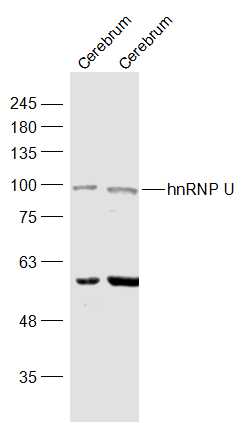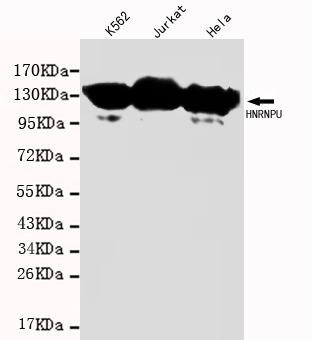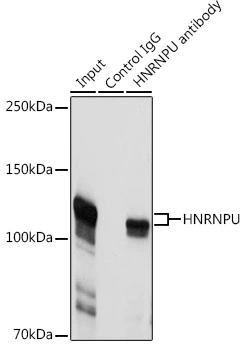![ICC/IF analysis of C6 cells using GTX02839 hnRNP U antibody [GT1242]. Dilution : 1:100 Blue : DAPI for nuclear staining. ICC/IF analysis of C6 cells using GTX02839 hnRNP U antibody [GT1242]. Dilution : 1:100 Blue : DAPI for nuclear staining.](https://www.genetex.com/upload/website/prouct_img/normal/GTX02839/A4257_IF_01_(1072306)_w_23053123_648.webp)
ICC/IF analysis of C6 cells using GTX02839 hnRNP U antibody [GT1242]. Dilution : 1:100 Blue : DAPI for nuclear staining.
hnRNP U antibody [GT1242]
GTX02839
ApplicationsImmunoFluorescence, ImmunoPrecipitation, Western Blot, ImmunoCytoChemistry, ImmunoHistoChemistry, ImmunoHistoChemistry Paraffin
Product group Antibodies
TargetHNRNPU
Overview
- SupplierGeneTex
- Product NamehnRNP U antibody [GT1242]
- Delivery Days Customer9
- Application Supplier NoteWB: 1:500 - 1:2000. ICC/IF: 1:50 - 1:200. IHC-P: 1:50 - 1:200. IP: 1:50 - 1:200. *Optimal dilutions/concentrations should be determined by the researcher.Not tested in other applications.
- ApplicationsImmunoFluorescence, ImmunoPrecipitation, Western Blot, ImmunoCytoChemistry, ImmunoHistoChemistry, ImmunoHistoChemistry Paraffin
- CertificationResearch Use Only
- ClonalityMonoclonal
- Clone IDGT1242
- Concentration0.15 mg/ml
- ConjugateUnconjugated
- Gene ID3192
- Target nameHNRNPU
- Target descriptionheterogeneous nuclear ribonucleoprotein U
- Target synonymsDEE54, EIEE54, GRIP120, HNRNPU-AS1, HNRPU, SAF-A, SAFA, U21.1, hnRNP U, pp120, heterogeneous nuclear ribonucleoprotein U, HNRNPU antisense RNA 1, heterogeneous nuclear ribonucleoprotein U (scaffold attachment factor A), nuclear p120 ribonucleoprotein, p120 nuclear protein
- HostRabbit
- IsotypeIgG
- Protein IDQ00839
- Protein NameHeterogeneous nuclear ribonucleoprotein U
- Scientific DescriptionThis gene encodes a member of a family of proteins that bind nucleic acids and function in the formation of ribonucleoprotein complexes in the nucleus with heterogeneous nuclear RNA (hnRNA). The encoded protein has affinity for both RNA and DNA, and binds scaffold-attached region (SAR) DNA. Mutations in this gene have been associated with epileptic encephalopathy, early infantile, 54. A pseudogene of this gene has been identified on chromosome 14. [provided by RefSeq, Jun 2017]
- Storage Instruction-20°C,2°C to 8°C
- UNSPSC12352203

![ICC/IF analysis of NIH-3T3 cells using GTX02839 hnRNP U antibody [GT1242]. Dilution : 1:100 Blue : DAPI for nuclear staining. ICC/IF analysis of NIH-3T3 cells using GTX02839 hnRNP U antibody [GT1242]. Dilution : 1:100 Blue : DAPI for nuclear staining.](https://www.genetex.com/upload/website/prouct_img/normal/GTX02839/A4257_IF_02_(1072307)_w_23053123_451.webp)
![ICC/IF analysis of U2OS cells using GTX02839 hnRNP U antibody [GT1242]. Dilution : 1:100 Blue : DAPI for nuclear staining. ICC/IF analysis of U2OS cells using GTX02839 hnRNP U antibody [GT1242]. Dilution : 1:100 Blue : DAPI for nuclear staining.](https://www.genetex.com/upload/website/prouct_img/normal/GTX02839/A4257_IF_03_(1072308)_w_23053123_308.webp)
![IHC-P analysis of rat liver tissue section using GTX02839 hnRNP U antibody [GT1242]. Dilution : 1:100 IHC-P analysis of rat liver tissue section using GTX02839 hnRNP U antibody [GT1242]. Dilution : 1:100](https://www.genetex.com/upload/website/prouct_img/normal/GTX02839/A4257_IHC_01_(1071809)_w_23053123_753.webp)
![IHC-P analysis of human thyroid cancer section using GTX02839 hnRNP U antibody [GT1242]. Dilution : 1:100 IHC-P analysis of human thyroid cancer section using GTX02839 hnRNP U antibody [GT1242]. Dilution : 1:100](https://www.genetex.com/upload/website/prouct_img/normal/GTX02839/A4257_IHC_02_(1071810)_w_23053123_642.webp)
![IHC-P analysis of mouse liver tissue section using GTX02839 hnRNP U antibody [GT1242]. Dilution : 1:100 IHC-P analysis of mouse liver tissue section using GTX02839 hnRNP U antibody [GT1242]. Dilution : 1:100](https://www.genetex.com/upload/website/prouct_img/normal/GTX02839/A4257_IHC_03_(1071811)_w_23053123_503.webp)
![IP analysis of K562 whole cell lysate using GTX02839 hnRNP U antibody [GT1242]. Total extract : 300microg IP antibody amount : 3microg Dilution : 1:1000 IP analysis of K562 whole cell lysate using GTX02839 hnRNP U antibody [GT1242]. Total extract : 300microg IP antibody amount : 3microg Dilution : 1:1000](https://www.genetex.com/upload/website/prouct_img/normal/GTX02839/CutImage_A4257_IP_01_(1080389)_w_23053123_277.webp)
![WB analysis of various samples using GTX02839 hnRNP U antibody [GT1242]. Dilution : 1:1000 Loading : 25microg WB analysis of various samples using GTX02839 hnRNP U antibody [GT1242]. Dilution : 1:1000 Loading : 25microg](https://www.genetex.com/upload/website/prouct_img/normal/GTX02839/CutImage_A4257_WB_01_(1070389)_w_23053123_882.webp)
![Various whole cell extracts (30 microg) were separated by 5% SDS-PAGE, and the membrane was blotted with hnRNP U antibody [GT1242] (GTX02839) diluted at 1:1000. The HRP-conjugated anti-rabbit IgG antibody (GTX213110-01) was used to detect the primary antibody. Various whole cell extracts (30 microg) were separated by 5% SDS-PAGE, and the membrane was blotted with hnRNP U antibody [GT1242] (GTX02839) diluted at 1:1000. The HRP-conjugated anti-rabbit IgG antibody (GTX213110-01) was used to detect the primary antibody.](https://www.genetex.com/upload/website/prouct_img/normal/GTX02839/GTX02839_4000000942_20210122_WB_2_w_23053123_816.webp)
![Whole cell extract (30 microg) was separated by 5% SDS-PAGE, and the membrane was blotted with hnRNP U antibody [GT1242] (GTX02839) diluted at 1:1000. The HRP-conjugated anti-rabbit IgG antibody (GTX213110-01) was used to detect the primary antibody. Whole cell extract (30 microg) was separated by 5% SDS-PAGE, and the membrane was blotted with hnRNP U antibody [GT1242] (GTX02839) diluted at 1:1000. The HRP-conjugated anti-rabbit IgG antibody (GTX213110-01) was used to detect the primary antibody.](https://www.genetex.com/upload/website/prouct_img/normal/GTX02839/GTX02839_4000000942_20210122_WB_w_23053123_128.webp)





